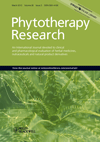Acetyl- and Butyryl-cholinesterase Inhibitory Activities of Mansorins and Mansonones
Abstract
Cholinesterase (ChE) inhibitory activities of three coumarins (mansorins A–C) and five naphthoquinones (mansonone C, E, G and H) were evaluated to determine the relationships between the acetylcholinesterase (AChE) and butyrylcholinesterase (BChE) inhibitory effects and the core structures of these compounds. Among the tested compounds, mansonone E exhibited the highest ChE inhibitory activities, with IC50 values in the low micromolar levels. In addition to revealing the ChE inhibitory activities of naphthoquinones for the first time, the results also revealed structure–activity relationship information that could be useful for further modification. Furthermore, the study also supports the hypothesis that mansonones are the active component in Thespesia populnea, a plant that previously has been shown to enhance memory activity in an in vivo study. Copyright © 2011 John Wiley & Sons, Ltd.




